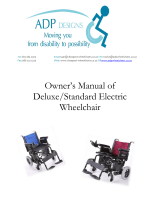
Sigma, Sigma 230
2019-08
Before use
6
2 Before use
2.1 Intended use
In this paragraph a brief description of the intended use of your wheelchair is given. Additionally,
relevant warnings are added to the instructions in the other paragraphs. In this way we would like
to make you aware of the possible misuse that may appear.
• This wheelchair is suitable for indoor and outdoor use.
• This wheelchair is designed and produced solely to transport/transfer one (1) person with a
maximum weight of 150kg. It is not designed for transportation of goods or objects, nor for
any use other than previously described.
• This wheelchair is meant to be operated by the user sitting in the wheelchair. You should
NOT use this wheelchair if you suffer from physical or mental impairments that may put you,
or other people, in danger when driving the wheelchair. For this reason, consult your doctor
first and make sure that your specialist dealer is informed about his advice.
• Only use accessories and spare parts approved by Vermeiren.
• Please read all technical details and limits of your wheelchair in chapter 5.
• The warranty on this product is based on normal use and maintenance as described in this
manual. Damage to your product caused by improper use or lack of maintenance will cause
the warranty to lapse.
2.2 General safety instructions
Risk of injuries and/or damage
Please read and follow the instructions in this manual. Otherwise you may get injured or your
wheelchair may get damaged.
Keep the following general warnings in mind during use:
• Do not use your wheelchair if you are under influence of alcohol, medicines or other
substances that may influence your driving abilities.
• Be aware that some parts of your wheelchair may get very hot or cold due to ambient
temperature, solar radiation, heating devices or due to the motor drive during the ride. Be
careful when touching. Wear protective clothing if the weather is cold. After a ride, wait until
the wheelchair/motor has cooled down.
• Before switching the wheelchair on, be aware of the environment/situation in which you are
located. Adjust your speed to this before driving off. We advise you to use the slowest speed
setting to drive indoors. For outdoor driving you can adjust the speed to a suitable speed at
which you feel comfortable and safe.
• ALWAYS keep in mind that your wheelchair may stop suddenly due to a discharged battery
or a protection that prevents your wheelchair from further damage. Also check the possible
causes mentioned in § 4.3. Use your safety belt to prevent injuries.
• Your wheelchair has been tested for electromagnetic compatibility and complies with the
standard, see chapter 6. Nevertheless, sources of electromagnetic fields may influence the
driving performance of your wheelchair, such as the fields of mobile phones, power
generators or high-power energy sources. On the other hand, the electronics of your
wheelchair can affect other electronic appliances too, such as alarm systems of shops and
automatic doors. We therefore advise you to check your wheelchair regularly for damage
and wear, since these may enlarge the interference (see also chapter 4).





















